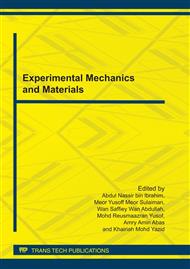p.185
p.191
p.197
p.204
p.210
p.216
p.224
p.230
p.237
The Influence of Stress Ratio on Changes in Magnetic Flux Density around Fatigue Crack Tips of Carbon Tool Steel
Abstract:
Fatigue failure of steel occurs when cracks form in a component and continue to grow to a size large enough to cause fracture. In order to understand the strength of a steel component, it is important to locate these cracks. We developed a scanning Hall probe microscope (SHPM), equipped with GaAs film sensors to observe fatigue cracks at room temperature in air while they were growing. In our previous works [1,2], the correlation between crack growth and magnetic field in high carbon tool steels (JIS SKS93 and JIS SUJ2) were determined. We also reported the sensitivity of the SHPM equipped with a three-dimensional line-probe that was developed to decrease the sensor gaps. By using the line-probe sensor we succeeded to measure the magnetic flux density distributions in very close proximity to the specimen’s surface. However, in order to further understand the relation between magnetic flux density and crack growth, other materials, microstructures and fatigue test conditions should be evaluated. In the present work, we focus on the effect of stress ratios on the changes of the magnetic flux density in annealed carbon tool steel.
Info:
Periodical:
Pages:
210-215
Citation:
Online since:
July 2011
Keywords:
Price:
Сopyright:
© 2011 Trans Tech Publications Ltd. All Rights Reserved
Share:
Citation:


